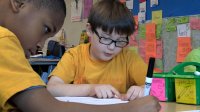Learning From Peers’ Strengths
Students can improve their work by learning to recognize the strengths in the work of their peers.
Overview
Starting at 3 years old, students learn the critique protocol at Two Rivers Public Charter School, a pre-K to eighth-grade Expeditionary Learning (EL) Education school in Washington, DC. By analyzing and identifying high-quality aspects of a piece of work, students can apply those high-quality attributes to their own work. The critique protocol can be done as a whole class, in small groups, or in pairs.
How It's Done
1. Identify the critique norms. Two Rivers Public Charter School uses the critique protocol rules—be kind, be specific, and be helpful—developed by Ron Berger, the Chief Academic Officer of EL Education. To engage your students more deeply with these rules, Jodi Arellano, a seventh-grade English teacher, suggests asking and then facilitating a discussion around the question, “Which rule is the most challenging to follow?”
2. Model identifying strengths. To build your students’ comfort with critique, start by mentioning the strengths of the work you’re critiquing. “It’s not about sugarcoating things,” explains Arellano. “It is about taking the time to recognize the efforts that the person you’re critiquing has made in this piece.”
3. Have your students analyze exemplary work. The work can range from an essay to a math answer to a scientific drawing. “What are the attributes that make one piece high quality versus another? Help your kids analyze those attributes so that they can own them and then use them in their own work,” explains Jeff Heyck-Williams, the director of curriculum and instruction.
4. Choose what work to show your students. Build comfort around giving and receiving critique by having your students critique your work—showing them that they can even help their teacher improve. Bring in high-quality examples from people outside of the class: older students, college students, or professionals like Maya Angelou or Jackson Pollock. Highlight a student’s work. “Pick a piece of work that is going to help your kids move towards a vision of high quality,” advises Heyck-Williams. “It doesn’t have to be an exemplar, but it does have to have elements that when kids look at it, they can see the difference between what is quality and what is not.”
5. Choose your critique focus. “You can’t effectively facilitate a critique session if you don’t have a vision of what you want your kids to get better at,” says Heyck-Williams. Arellano has her students focus on showing versus telling for one critique cycle and then rhyme schemes for another when working on poems highlighting the abolitionist movement. “The key to critique is that it’s about the kids articulating those attributes and therefore owning them in a way that they wouldn’t if a teacher just gave them a rubric,” explains Heyck-Williams.
6. Have your students identify takeaways from the critique. What will they apply to their own work?
7. Repeat. Do multiple critique cycles. As your students create multiple drafts—and see their work improve—they’ll realize the value of critique and revision. Filmed by EL Education, “Austin’s Butterfly, a true story about a Presumpscot Elementary School first-grade student who was tasked with making a scientific drawing of a tiger swallowtail butterfly, shows the impact of feedback and revision on creating high-quality work.
